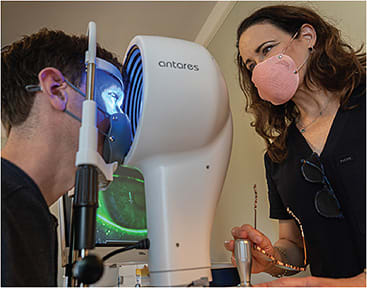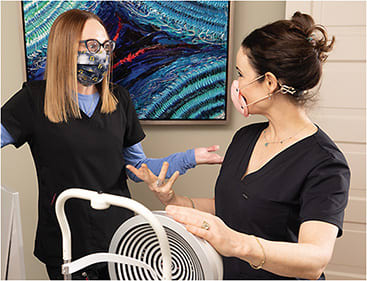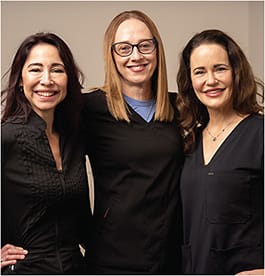PHOTOGRAPHY BY ASA MATHAT

While many private-practice ophthalmologists were assessing how to keep their businesses afloat during the initial wave of the COVID-19 pandemic, Laura M. Periman, MD, decided to launch her own ship, so to speak: the Periman Eye Institute, not far from Seattle’s Elliott Bay. A year and 8 months later, the concierge, dry eye disease (DED), clinical trial, and ocular aesthetics practice remains firmly anchored in the Emerald City, and it’s growing.
“When Dr. Periman was treating patients on her own, she was able to see roughly eight patients a day,” explains Christeen DeNeui, COA, office administrator, clinical trial coordinator and an ophthalmic assistant at the practice, who was Dr. Periman’s sole employee to start. “Now, with two ODs, a master aesthetician, a tech, and a billing person, the practice has doubled that number.”
Although mask-related DED and eye fatigue from increased screen time may have played some part in the practice’s sustainability, members of the Periman Eye Institute credit the following as the main reasons for the practice’s success.
Passion
Dr. Periman’s fervor for helping patients instills the same passion in the staff. In addition, patients comment on this passion and then share that enthusiasm with their family and friends, which has led to patient referrals.
"I met Dr. Periman at an optometrist’s practice where I was learning to become a tech," Ms. DeNeui explains. "I was also a dry eye sufferer. Through my training, I had the opportunity to observe Dr. Periman, and I was both inspired and impressed by how she interacted with patients. She really listened to them and asked so many questions to try to determine how to best help them. I remember one day when she informed a patient their DED might be tied to an undiagnosed autoimmune disease, and it turned out it was!"
Ms. DeNeui adds that witnessing patient reactions when they finally achieve symptomatic relief has been inspiring and heartwarming. “I just had to be a part of helping these patients too,” she offers.
Raquel McJunkin, Periman Eye Institute’s master aesthetician and clinical study coordinator, says she met Dr. Periman at an aesthetics event where they “just clicked,” subsequently deciding they had to work together.
“She educated me on the fact that there is a lot of crossover between aesthetics and DED, and I loved how passionate she was about wanting to help DED patients,” Ms. McJunkin says.
Natasha Balani, OD, who is one of the practice’s ocular surface disease clinical research fellows, says she was impressed with Dr. Periman’s scientific approach to diagnosis and treatment, which “improves the patient’s prognosis and their level of faith in doctors.”
“Seeing her use the data to really dive into the specific underlying cause, and then apply the correct treatment for a successful outcome on the back end, was really what spoke to me,” she says.
Sathi Maiti, OD, is another ocular surface disease clinical research fellow who also assists with patients. She says that Dr. Periman’s devotion to DED patients is evident in the education she provides her patients — something the staff members try to emulate themselves.
“Dr. Periman takes the time to provide the specifics and answer any patient questions,” she says. “You can see how much patients appreciate how knowledgeable she is, because it’s all in the name of helping them.”


Listening
Another reason for success is that the Periman Eye Institute staff listens intently to one another to discern when assistance is needed.
“We all have our ears open, so we are attuned to when a fellow staff member needs help,” Ms. DeNeui explains. “Often, we don’t even have to ask for help; someone just jumps in.”
Ms. McJunkin says cross-training, accomplished by observing Dr. Periman and fellow staff members, has allowed for lending a hand. “If, for example, I’m in the midst of completing information for a clinical trial patient and a patient presents needing IPL (intense pulsed light), Christeen [Ms. DeNeui] will jump in on completing the information for the clinical trial, while I pivot to take care of the patient who needs IPL,” she says.
Having that help when needed can be huge in terms of preventing staff from feeling overwhelmed while also limiting patient wait times.
“I think one of the things that’s unique about all the team members is that underlying level of self-direction,” Dr. Balani offers. “For a small practice, there isn’t necessarily time or the flexibility to not have that.”

Streamlining the visit
In recognizing the practice would open amid a pandemic, Dr. Periman and Ms. DeNeui created a plan to streamline the visit, so DED patients could be seen safely while still receiving exceptional care. This, in turn, enabled the practice to build a patient base, despite COVID-19. This plan:
- Place all intake forms/online scheduling on the practice website. “On our intake form, we ask about screen time, diet, dry eye treatments tried, exercise, smoking, vaping, CPAP use, medication use, acne, Accutane and Botox treatments, cosmetics (e.g., lash extensions), and a family history of autoimmune disease,” Ms. McJunkin says.
- Scheduling a telemedicine visit. Once Ms. DeNeui receives the patient forms, she sets up a telemedicine visit, so Dr. Periman can get to know the patient sans masks while asking them follow-up questions designed to further determine the root cause of the patient’s DED and what untried treatments may work. An example of a follow-up question: “Of the treatments you tried, what do you think worked best for you?”
- In-practice diagnostic testing. Next, patients present in-office, one at a time, and spaced out, for diagnostic testing, including InflammaDry (Quidel), the TearLab Osmolarity System (TearLab), slit lamp photography (Eyefficient) and meibography (Antares), Ms. McJunkin notes.“In using the results of the diagnostic testing, Dr. Periman prescribed specific in-office treatments and at-home treatments to support them, and Christeen [Ms. DeNeui] scheduled these appointments, again one patient at a time and spaced out,” Ms. McJunkin says.
- In-practice treatments. Periman Eye Institute utilizes IPL (OptiLight, Lumenis), microblepharoexfoliation (AB Max), Systane iLux (Alcon), Maskin Probing, Botox (Allergan) and radio frequency, among other in-practice treatments, to enable patients to achieve symptomatic relief, Dr. Periman says. It’s worth noting that Dr. Periman created her own IPL protocol — an extension of the Toyos protocol — which can be accessed in six YouTube videos (bit.ly/3ApFQo8 ).“Raquel [Ms. McJunkin] assists with the in-office treatments,” she says. “After the prescribed course of treatment, Christeen [Ms. DeNeui] then schedules the patient for a follow-up appointment where I can determine the treatment's success and determine the next course of action.”
- Curated at-home treatments. Patients are offered products and devices focusing on hygiene, nutrition, medications and skin care for a comprehensive care plan. For patient’s convenience and at home success, a variety of home care items are offered, including hygiene systems (NuLids, ZocuShield, Scope Lid Wipes and Tea Tree Oil Gel), heat mask and nightwear masks (Eyeeco), specialized eye drops (Scope, RegenerEyes), the Nanodropper adapter, nutritional supplements HydroEye (ScienceBased Health) and CurcuOne (Wellness 26), compounded rosacea and seborrheic dermatitis products, neurostimulation (iTear100), and ocular surface friendly skin care.
- Remote clinical trials. “At the height of the pandemic, we were developing a clinical trial questionnaire for one of the pharmaceutical companies, and the bulk of that work was done remotely,” Dr. Balani says. “We were able to do the interviews remotely, and we were able to send the study compensation to the study participants.”
Dr. Periman says this pandemic protocol has worked so well, they’ve continued using much of it.

Supporting patients
Periman Eye Institute staff members also attribute the practice’s prosperity to the patient education and support the practice provides, which creates patient loyalty and referrals.
“We all spend a lot of time educating patients, and they have told us how much they appreciate having an understanding of their disease and the purpose of diagnostic devices and in-office treatments,” explains Ms. McJunkin. “For example, when I perform IPL treatments, I use the analogy of a garden when explaining to the patient why I treat the entire face vs. just the DED: ‘When you have a garden, you remove all the weeds, not just the weeds around the flowers.’”
She notes that she reinforces the importance of Dr. Periman’s treatment plan during the use of in-office treatments, so patients understand that if they don’t use their drops and home care plan as prescribed, for example, the in-office treatment isn’t going to be as effective.
"Human beings need to hear things more than one time in order for it to stick," Dr. Periman emphasizes. "So we educate them about the seriousness of DED and the impact of treatment on the intake forms; the telemedicine visit; during diagnostic testing; during in-office treatments; and at follow-up appointments. Our patients are extraordinarily well educated, which helps them intuitively make the right choices regarding their care."
In addition to verbal communication, Dr. Periman says she uses clinical images to show patients, for example, their clogged meibomian glands or corneal staining, so that they can “see” their disease, as well as their improvements, which then motivates them to adhere to their prescribed treatment plan.
“It’s rewarding to open people’s eyes — no pun intended — about the seriousness of DED, its chronic nature and how we can help,” explains Dr. Maiti.
Periman Eye Institute staff say they also make a point of providing support to patients from when they visit the website to make an appointment all the way through to post-treatment follow-up visits.
“I’m the person patients are invited to email regarding questions about their intake forms and their appointments,” Ms. DeNeui points out. “When patients don’t understand something on the forms or need guidance, I help them through it. When patients are skittish or scared about their appointments, I immediately let Dr. Periman and Raquel [Ms. McJunkin] know, who then personally reach out to those patients to calm their fears.”
Dr. Periman notes her staff members are quick to provide encouragement to patients when they haven’t yet experienced a tangible improvement in their symptoms, as clinical signs often don’t match symptoms in DED.
“I’ll often show them before and after clinical images, improvements in osmolarity or inflammation, so they can see the prescribed treatment has started to work,” she says.
Smooth sailing
“I think there’s a really awesome synergy here where we’re all pursuing the reward of patients feeling better, seeing better, looking better,” Dr. Periman stresses. “We all cheer our patients’ successes. So, it’s really everybody leaning in.”
It’s clear Periman Eye Institute’s ship has come in. OP








